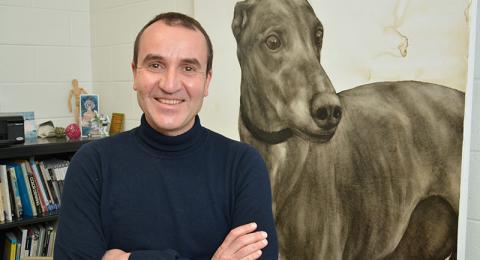Drawing textbook profiles SUNY Oswego professor's artwork, technique
Office of Communications and Marketing
Published
The new edition of “Drawing Essentials: A Complete Guide to Drawing,” a textbook published by Oxford University Press, profiles mixed-media artist Juan Perdiguero of the SUNY Oswego art faculty among about 20 others in an appendix of top talents influencing modern drawing.
Deborah A. Rockman’s large soft-cover book also features three glossy pages of Perdiguero’s drawings.
The Oswego artist, originally from the Spanish capital of Madrid, said he first heard about a year ago from Rockman, whose third edition of the text appeared recently.
“She told me she had been following my work for several years,” Perdiguero said. “She had the opportunity to see my work at an exhibition in Chicago.”
Traditionally a classical artist, Perdiguero’s distinction arises from his methodology. Rockman cited his “use of etching ink and linseed oil on photographic emulsion” that lends his pieces “an ambiguous pictorial sense.”
In what the artist calls a technique that creates a “hybrid ... of different approaches,” Perdiguero told the Oswego alumni magazine he uses paper towels, cotton swabs and his hands, drawing large-scale, lifelike images by wiping away black etching ink from non-absorbent, luminescent photographic paper in a technique he spent more than 20 years perfecting.
Rockman, a professor of art at Ferris State University’s Kendall College of Art and Design, also noted Perdiguero’s characteristic subjects: animals such as dogs, monkeys, apes, birds and, more recently, deer, often almost photographically realistic but set against abstract or surreal landscapes. One of his pieces, of a large dog, graced the front of Penfield Library on a banner for about two years.
The artist worked with the human figure until 2005, when he realized the artwork simply wasn’t conveying his intent adequately. “I wanted to move toward the political,” he said. “Each animal represents either a person or a human emotion.”
Perdiguero added, “Animals are interesting because you can project your humanity on them.”
First arriving in the United States in 1990 for a second master’s degree at the University at Buffalo, Perdiguero later worked in New York City as an artist, supplementing his income with art restoration for museums. He joined SUNY Oswego’s art faculty in 2002. In the past two years, his work has appeared at galleries in Madrid, Zaragoza and Cordoba in Spain, as well as in Richmond and at the Rochester Contemporary Art Center.



